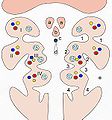Feature of vertebrate embryos
In the embryonic development of vertebrates, pharyngeal pouches form on the endodermal side between the pharyngeal arches. The pharyngeal grooves (or clefts) form the lateral ectodermal surface of the neck region to separate the arches.
Specific pouches
First pouch
The endoderm lines the future auditory tube (pharyngotympanic Eustachian tube), middle ear, mastoid antrum, and inner layer of the tympanic membrane. Derivatives of this pouch are supplied by Mandibular nerve.
Second pouch
Third pouch
- The third pouch possesses dorsal and ventral wings. Derivatives of the dorsal wings include the inferior parathyroid glands, while the ventral wings fuse to form the cytoreticular cells of the thymus. The main nerve supply to the derivatives of this pouch is cranial nerve IX, glossopharyngeal nerve.
Fourth pouch
Derivatives include:
- superior parathyroid glands and ultimobranchial body which forms the parafollicular C-Cells of the thyroid gland.
- Musculature and cartilage of larynx (along with the sixth pharyngeal arch).
- Nerve supplying these derivatives is Superior laryngeal nerve.
Fifth pouch
- Rudimentary structure, becomes part of the fourth pouch contributing to thyroid C-cells.[1]
Sixth pouch
- The fourth and sixth pouches contribute to the formation of the musculature and cartilage of the larynx. Nerve supply is by the recurrent laryngeal nerve.
Additional images
See also
References
External links



